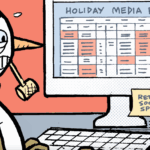 One year after the acquisitions of Adometry and Convertro by Google and AOL respectively, new breeds of attribution vendors are surfacing from periods of R&D hibernation, and they’re aiming to capitalize on what they and other observers see as openings in the market.
One year after the acquisitions of Adometry and Convertro by Google and AOL respectively, new breeds of attribution vendors are surfacing from periods of R&D hibernation, and they’re aiming to capitalize on what they and other observers see as openings in the market.
The optimism comes from the belief that advertisers won’t pay for attribution from companies like Google and AOL that sell media, and that have a vested interest in ensuring that their inventory comes out on top.
“They’ll say they’re independent, but the reality is that Google gets half of every mobile dollar,” said Steve Latham, founder and CEO of Encore Media Metrics. “We see clients who like the efficiency, but [Google] charges a lot of money for data transfer files if you want to analyze what you’re doing through DoubleClick. And that’s after you’ve paid for the ad serving that generated the data.”
Abakus, an attribution software provider, was founded in 2013 when former CTO of Exponential – and current CEO of Abakus – Alex Saldanha broke with ad network Exponential to form an independent company. “We quickly realized this is something that needs to be outside of media,” said Abakus co-founder and VP of product Graham Ratcliffe, who also came from Exponential. Ratcliffe said that as a potential product on offer from Exponential, clients were telling them, “We’re not sure about giving you our cost data … because you’re on our media plan.”
Conversion Logic, a company founded in 2014 by CEO Trevor Testwuide and COO Alison Lohse, both of whom previously worked at Visual IQ, also takes the position that Adometry and Convertro overexpose clients’ media budgets. “If you’re a holding company or agency and you’ve worked hard to get preferred pricing for your network, or a brand that’s garnered preferred pricing through spend, sharing that information with a competitor creates concerns,” said Lohse.
But Tina Moffett, a Forrester analyst who studies attribution technology, isn’t fully sold on that supposition and said the issue is both real and somewhat overblown. “It’s brought up in every conversation I have with brands,” she said. “But I don’t think that the platforms … would risk the relationship with the brand, in terms of re-jiggering the algorithm to favor [themselves].”
For a platform like AOL, with cross-channel properties and a renewed focus on holistic ad services, having attribution technology makes too much sense for these concerns to make an impact. “We have created best-in-class multitouch attribution infrastructure and disciplined processes … to ensure there is a clear separation of church and state,” said an AOL spokesperson. “Further, advertisers are awash with data and insights; they are demanding platform(s) to make them actionable in a programmatic way, from web to TV. Point solutions are not in a position to lead that charge, which is why we invested in and developed ONE by AOL.”
Google declined to comment.
Even as attribution start-ups try to capitalize on FUD around Google and AOL, they also believe there’s a major opportunity in expanding attribution services to mid-tier companies. As Testwuide noted, “Traditionally, we’ve seen attribution only really make sense to a company that’s spending tens of millions on marketing.”
The first wave of attribution companies primarily targeted Fortune 500 companies, as their software wasn’t plug-and-play, but they required a consultative relationship involving a months-long onboarding process and integrated operations.
Ratcliffe believes that Adometry’s acquisition was as much about the service as the technology. “Google wanted to be able to provide that white-glove service and human capital,” he said.
This emerging breed of attribution vendor eschews the laborious process and deep sales cycles that have dictated the market until now.
Conversion Logic, for instance, still takes an involved, operational role with its clients, but sees its ability to streamline that process as a differentiator (and part of the reason why the entrepreneurs branched out from Visual IQ). “The opportunity is to do things quickly,” said Lohse. “Data was not getting to clients quickly enough, and implementation was so painful that it often undermined the process before it even got started.” Being able to efficiently onboard clients is for attribution start-ups perhaps the most important driver of scalability.
Abakus takes it a step further still, streamlining the company by removing data scientists from the equation and offering itself as an agnostic software tool. “Others go in [to pitch attribution technology] and say they’ll provide a dedicated PhD to your account, and for them, that’s a selling point. I’m using that as a negative,” said Ratcliffe.
A key part of Abakus and others’ growth strategy is spreading their software through partner networks. For example, Abakus partners with Sizmek to provide optimization services to its clients. Ratcliffe considers that kind of “white-labeling” to be a future driver of attribution adoption, as well as a gateway to smaller clients.
Latham still sees value in Encore Media Metrics having its own data science team. “Most [clients] prefer to outsource such specialized work to experts,” he said. He also stressed the importance, as did Conversion Logic and Abakus, of having had the opportunity to survey the market and pivot toward “a more partner-centric than services-centric approach.”
Moffett echoed the importance of that incubation period for companies looking to establish themselves in the space. “I think one advantage [attribution start-ups] do have is they were able to see the market needs and where the gaps were … and where existing players were falling short,” she said.












